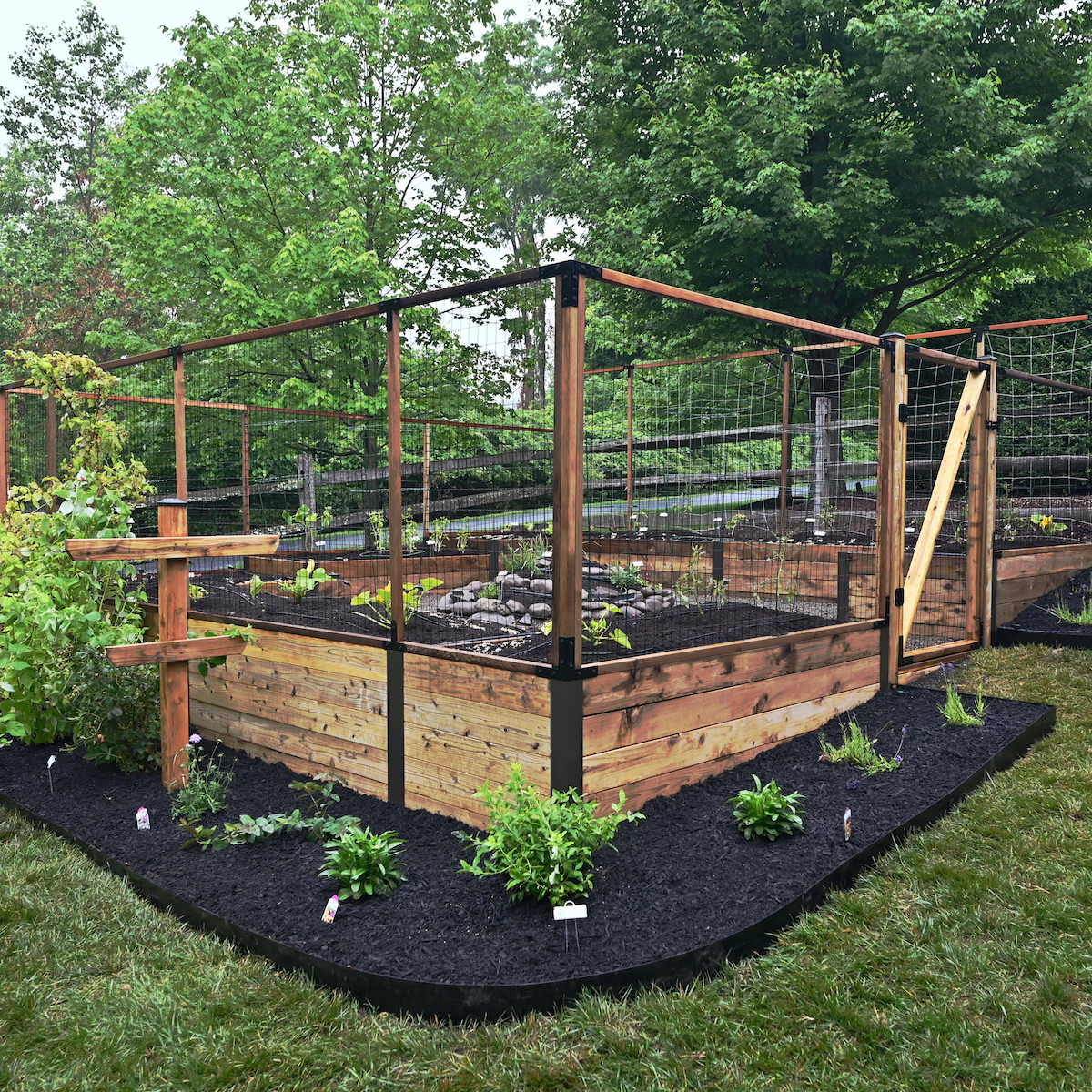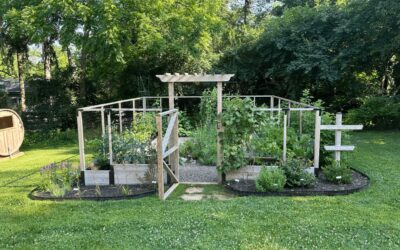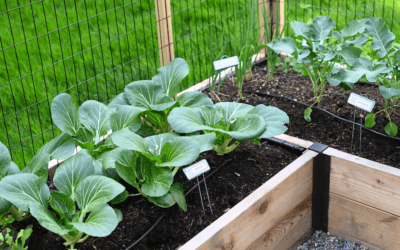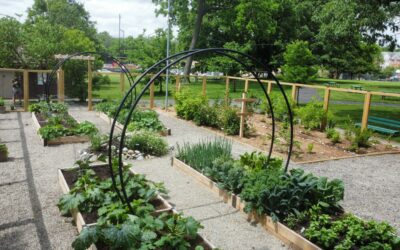- Introduction to Raised Bed Gardening
- What Is a Raised Bed Garden?
- The Benefits of Raised Bed Gardens: Why Choose Them?
- Raised Bed Materials: Making the Right Choice For Your Garden
- Raised Bed Placement: Finding The Perfect Location
- Soil and Fertilizer in Raised Beds: Maximizing Growth Potential
- Plant Selection for Raised Bed Gardens: What Thrives in Elevated Planters
- Irrigation and Drainage Solutions for Raised Beds
- Seasonal Maintenance and Care Tips for Raised Beds
- How To Start Building Your Raised Bed Garden
Introduction to Raised Bed Gardening
The desire for mental and physical wellness and a connection to nature often inspires people to garden, but the prospect of starting your own garden can be overwhelming. With thousands of search results at your fingertips, there’s a lot of information out there: some self-conflicting and not all based on science. Beginner DIY gardeners may find themselves overwhelmed, and unsure of where to begin.
If you’re looking for an easy and rewarding way to learn how to garden, consider choosing a raised bed garden. This method is perfect for beginner DIY gardeners, and offers numerous benefits that also make it a popular choice among experienced gardeners.
Backyard Eats has guided over 300 clients to achieving their gardening goals using raised beds and repeatable, time-tested methods. As a full-service food gardening company, we have built an exhaustive process to deliver success the first time, every time.
In this comprehensive guide, we’ll explore the world of raised bed gardening, breaking down the essential components you need to know to get started.
First, we’ll explore the many benefits that raised bed gardens provide, from improved soil quality to easier weed control. Next we’ll discuss the various materials you could choose when constructing your raised beds, and why we recommend treated cedar and hemlock boards. We’ll also help you determine the ideal location for your raised bed garden, considering factors like sunlight, drainage, and accessibility.
After reading this article, you will be able to take the first steps towards your own home gardening project! Discover how raised bed gardening can not only transform your outdoor space but also contribute to a healthier, more sustainable lifestyle.

What Is a Raised Bed Garden?
A raised bed garden is a gardening method that involves growing plants in elevated containers or planting areas, as opposed to traditional in-ground gardening. Raised beds are created by constructing an enclosure that raises the planting area above ground level. Common building materials include wood, stone, and concrete.
The primary defining feature of raised bed gardens is their contained and elevated nature, making them distinct from the surrounding soil. This method allows gardeners to have greater control over the quality of the soil, drainage, and other environmental factors, which can lead to improved plant growth and easier maintenance.
Why are Raised Beds Popular for Vegetable Gardening
Raised bed gardens are popular for their versatility and are used for cultivating a wide variety of plants, including vegetables, herbs, flowers, and more. They present an ideal method whether you have a small urban backyard or a larger landscape.
The Benefits of Raised Bed Gardens: Why Choose Them?
Should I build a raised bed garden or in-ground garden?
Raised bed gardens provide many benefits that make growing food a simple and enjoyable experience. Raised beds offer improved soil quality because they can be filled with a custom blend of soil, compost, and other organic materials that supply necessary nutrients to annual crops. In contrast, in-ground gardens may contain soil contaminants that are potentially harmful to consume via plants.
Raised beds’ elevated structure also aids in weed control and reducing interference from ground-dwelling pests like rabbits. Increased bed height also makes tasks like planting, weeding, and harvesting more comfortable than bending or kneeling down.
Overall, a raised bed garden is an accessible and productive way to grow a variety of crops, enhancing both your garden and your overall gardening experience.
Raised Bed Materials: Making the Right Choice for Your Garden
What should I use to build a raised bed garden?
Selecting the right materials for your raised bed garden is a crucial decision that will greatly influence the longevity, functionality, and aesthetics of your garden. The best materials for a raised bed garden depend on your specific needs and preferences. Commonly used DIY materials for constructing raised beds include wood, stone, concrete blocks, and composite materials.
Wooden raised beds are a popular choice for their natural and rustic appearance. Cedar and redwood are particularly favored due to their natural resistance to decay and insects, which extends the life of the bed.
At Backyard Eats, we build our raised beds using thick cedar or hemlock boards treated with a food-safe wood stabilizer to protect your garden for 10-15 years.
Stone, such as limestone, rocks, or bricks, is another durable option for creating raised beds. Concrete blocks are also practical and versatile. However, both stone and concrete retain more heat than a wooden raised bed: leading to warmer soil and potentially frying the roots of tender young plants.
Store-bought raised bed kits are often made of thin metal, which may rust and warp over time.
Your choice of material should align with your garden’s aesthetic, your budget, and the level of maintenance you’re willing to commit to. Regardless of the material, a well-constructed raised bed will provide the advantages of better soil control, drainage, and weed management while enhancing the overall appeal of your garden space.
Raised Bed Placement: Finding the Perfect Location
Where should I put my raised bed garden?
Choosing the right location for your raised bed garden is a pivotal decision that can significantly impact the success of your gardening project. When determining where to put your raised bed garden, consider several key factors:
Ensure that your raised bed garden is physically and visually accessible. It should be convenient to reach without excessive walking or carrying heavy equipment. Proximity to your home or a water source also aids in the installation of drip irrigation. If your garden is “out of sight, out of mind,” you are less likely to notice problems or crops that are ready for harvest.
Can I build a raised bed garden in the shade?
One of the most critical factors is sunlight. Most vegetables and flowering plants require at least 6-8 hours of direct sunlight each day. Observe your potential garden area throughout the day to identify spots that receive adequate sunlight. South-facing locations often get the most sunlight, making them ideal for most crops. During your Initial Consultation, a Backyard Eats expert will advise you on the best placement for your garden.
Can I build a raised bed garden on a slope?
Good drainage is essential to prevent pooling water or shifting soil. Avoid low-lying areas that may collect excess water during heavy rainfall. Elevated sites will promote proper drainage, ensuring your plants’ roots remain healthy, but still require a stable base.
What size should my raised bed garden be?
The size of your garden also matters. Make sure the selected space can accommodate the dimensions of your raised bed(s) and any necessary walkways or pathways. We recommend a minimum pathway width of three feet for accessibility.
By carefully considering these factors, you can find the perfect location for your raised bed garden that maximizes sunlight, accessibility, and overall garden health! Remember that thoughtful placement will lead to a more successful and enjoyable gardening experience.

Soil and Fertilizer in Raised Beds: Maximizing Growth Potential
What type of soil is best for raised bed gardens?
The type of soil you use in your raised bed garden is of vital importance for the health and productivity of your plants. Organic materials play a vital role in creating nutrient-rich, well-draining soil for your raised beds. Annual vegetables in particular require looser soil and yearly nutrient replacement. Here are some key considerations for selecting the best soil for your raised bed garden:
Can I Put Leaves in My Raised Beds?
Begin with a base of rich organic matter, such as compost, well-rotted manure, or leaf mold. Organic matter enhances soil structure, increases water retention, and provides essential nutrients for plant growth. Compost is a versatile choice, as it helps balance soil pH and improve overall fertility.
What type of compost is best for raised beds?
Compost is a very broad term. Some people refer to broken-down organic matter as “mulch.” Whatever you choose to call it, make sure that the compost you purchase has been fully composted by a professional, as inadequately processed organic matter will contain pathogens, a plethora of weed seeds, and can actually rob nitrogen from the soil as it decomposes. Municipal (or Township) leaf compost is a great option for this reason. Not only is it affordable or free to residents, it is actively processed by a professional composter, and detailed records are maintained on the temperature and moisture content of the compost piles to ensure adequate processing.
At Backyard Eats, we use a custom growing medium that’s a blend of potting soil, coconut coir, and mushroom compost to achieve the optimal balance of nutrients and drainage.
How to Make Soil for a Raised Bed
You can create a DIY balanced soil mix by combining organic matter with garden soil. A common formula is a 1:1 ratio of garden soil and organic matter. Garden soil provides minerals, while organic matter improves texture and fertility. Annual plants have tender roots which especially benefit from a “fluffier” soil texture, unlike compact ground soil.
What Soil Amendments Should I Use For My Garden?
- Peat Moss: Peat moss can improve moisture retention and aeration, particularly in raised beds that tend to drain quickly. It is an excellent addition, especially for moisture-loving plants.
- Coconut coir is an eco-friendly alternative to peat moss and improves water retention. It’s a renewable resource and has excellent water-holding capacity.
- Soil Amendments: Based on your specific plant needs, consider adding additional organic nutrient amendments like bone meal, blood meal, or fish emulsion. These organic supplements provide essential macro and micronutrients to replenish the health of your soil and plants every year.
What pH Should Garden Soil Be?
Periodically test the pH of your soil to ensure it falls within the appropriate range for the plants you intend to grow. Many organic materials, like compost, help buffer the pH to a neutral or slightly acidic level, which is suitable for most plants.
Remember that organic materials not only improve soil fertility but also support the growth of beneficial soil microorganisms, which contribute to plant health. Tailoring your raised bed garden’s soil mix with organic materials will promote thriving and sustainable plant growth while reducing the need for synthetic fertilizers and harmful chemical inputs.
To learn more about the dangers of synthetic herbicides, read our blog post on the dangers of glyphosate a.k.a. “Round-Up”
Plant Selection for Raised Beds: What Thrives in Elevated Planters
What can I plant in raised bed gardens?
Raised bed gardens provide an ideal environment for growing a wide range of edible annual vegetables and herbs. When planning your raised bed garden, you can categorize your plant choices into several broad categories, allowing for diversity and effective crop rotation. Here are some categories of edible annuals suitable for raised bed gardens:
- Leafy Greens: Leafy greens like lettuce, kale, spinach, Swiss chard, and arugula thrive in raised beds. Their shallow root systems make them well-suited to the limited space of raised planters.
- Herbs: Herbs such as basil, cilantro, parsley, mint, and thyme flourish in raised beds. Their aromatic qualities can deter pests and enhance the flavors of neighboring plants.
- Tomatoes and Peppers: These fruiting vegetables benefit from the well-draining and fertile soil of raised beds. Consider trellising or staking these plants to maximize space.
- Root Crops: Vegetables like carrots, radishes, beets, and onions can be grown in raised beds with loose, well-draining soil. They appreciate the controlled soil conditions.
- Bush Beans and Peas: Compact varieties of beans and peas are well-suited for raised beds. Their vertical growth habit makes them ideal for saving space and maximizing yields.
- Cucurbits: Bush varieties of cucumbers, zucchini, and squash can be grown in raised beds. Just ensure that they have enough space to spread out.
- Spices: Grow spices like dill, coriander, and fennel to season your dishes and attract beneficial insects.
Before planting, it’s essential to plan the layout of your raised bed garden, taking into account plant heights, growth habits, and compatibility. Additionally, practicing crop rotation can help prevent soil depletion and disease buildup in your raised beds. By carefully selecting and arranging your edible annuals in the raised bed, you can enjoy a bountiful and diverse harvest throughout the growing season.
Backyard Eats extensive garden planning and planting process takes all the guesswork out of preparing your garden! Our interactive order form allows you to choose from dozens of popular and high-performance crops for spring and summer, automatically calculated to fit the exact size of your garden. We will rotate crops to help control pests, and use succession planting throughout the season to ensure your garden is never empty.
To learn more about our garden planning and planting process, click here.
Irrigation and Drainage Solutions for Raised Bed Gardens
Irrigation and drainage solutions are important considerations for maintaining a healthy and productive raised bed garden. While there are various methods to deliver water to your plants, drip irrigation stands out as an efficient and effective choice, offering several advantages over traditional hand-watering or “do-it-yourself” techniques.
Best Irrigation System for Raised Bed Gardens
Drip irrigation delivers water directly to the base of plants, minimizing water evaporation. This method ensures that plants receive the moisture they need without needless waste, making it one of the most water-efficient options available.
Drip irrigation provides a consistent and uniform water supply to each plant’s root zone. This promotes even growth and prevents under- or overwatering, which can lead to healthier plants and higher yields.
How to Control Weeds in a Raised Bed
Drip irrigation targets the root zones of your plants, reducing moisture around the soil surface. This minimizes weed growth in the surrounding soil, as weed seeds are less likely to germinate in drier soil, resulting in less weeding and maintenance.
How to Prevent Disease in a Raised Bed Vegetable Garden
Overhead watering can promote fungal diseases and leaf wetness. In contrast, drip irrigation helps keep plants dry and reduces the risk of diseases. This is especially beneficial for popular crops like tomatoes, which are susceptible to fungal issues.
How to Save Time and Money with a Raised Bed
Drip irrigation systems automate the watering process, reducing the time and effort required for hand-watering. This is particularly advantageous for busy gardeners or those with larger raised bed gardens.
In conclusion, while traditional DIY hand-watering methods have their place in gardening, the numerous benefits of drip irrigation, such as water efficiency, plant health, and time savings, make it a superior choice for maintaining a flourishing and low-maintenance raised bed vegetable garden.

Seasonal Maintenance and Care Tips for Raised Beds
Seasonal maintenance and care for raised bed gardens are essential to ensure year-round productivity and garden health. When maintaining a garden planted throughout spring, summer, and fall, consider the following seasonal tips to optimize your raised bed’s performance:
Spring Care Tips for Raised Bed Gardens (March to May):
- Soil Inspection: As the gardening season begins, inspect your raised bed’s soil. It may have settled or lost some nutrients during the winter. Top off the bed with fresh compost and organic matter to replenish nutrients and improve soil structure.
- Weed Control: Clear any early spring weeds that have emerged, as they can compete with your crops for nutrients and sunlight. Mulch the bed to suppress future weed growth.
- Pruning and Trellising: If you’re growing vining or tall plants like tomatoes and cucumbers, start pruning and trellising them to encourage healthy growth and good air circulation.
Summer (June to August):
- Regular Watering: Maintain a consistent watering schedule, as summer often brings hot and dry conditions. Drip irrigation systems can be especially beneficial during this period.
- Pest Management: Keep an eye out for threats like aphids and fungus. Regularly inspect your plants and use organic pest control methods when necessary.
- Harvesting: Begin harvesting your summer crops when they reach maturity to encourage continuous production. Regular harvesting can also prevent overcrowding in the raised bed.
Fall (September to November):
- Plant Fall Crops: As summer crops dwindle, replant your raised bed with cool-season vegetables like kale, carrots, and lettuce. These crops can thrive in the milder fall weather.
- Mulching: Apply mulch to insulate the soil and protect it from temperature fluctuations. Mulch also helps retain moisture and suppress weeds.
- Fall Clean-Up: Remove spent plants and any debris that could harbor pests or diseases. Compost healthy plant material and dispose of diseased plants to prevent the spread of pathogens.
- Protect from Frost: If you anticipate frost in your area, cover sensitive crops with frost blankets or row covers to extend the growing season.
- Raised Bed Inspection: Before winter sets in, inspect the structure of your raised bed. Ensure it’s still sturdy and make any necessary repairs to maintain its integrity.
Raised beds make it easier to address the specific needs of your crops throughout the changing seasons. By following these seasonal maintenance and care tips for your raised bed garden, you can enjoy an abundant harvest throughout the growing season while keeping your garden in prime condition for the next planting.
How to Start Building Your Raised Bed Garden
In a world where information overload can make the prospect of gardening feel overwhelming, raised bed gardening stands out as an accessible and rewarding choice for cultivating your own green oasis. With the proper knowledge and a bit of guidance, anyone can embark on this journey to create a thriving, beautiful garden.
If you’re ready to take the first step or enhance your existing raised bed garden, seize the opportunity today. Don’t let indecision hold you back! Book a consultation with Backyard Eats’ gardening experts who can provide personalized advice and offer hands-on assistance.
Transform your outdoor space and embark on a journey of sustainable gardening, healthy living, and personal satisfaction. Your dream garden is closer than you think—book your consultation today, and make your garden dream a reality!



